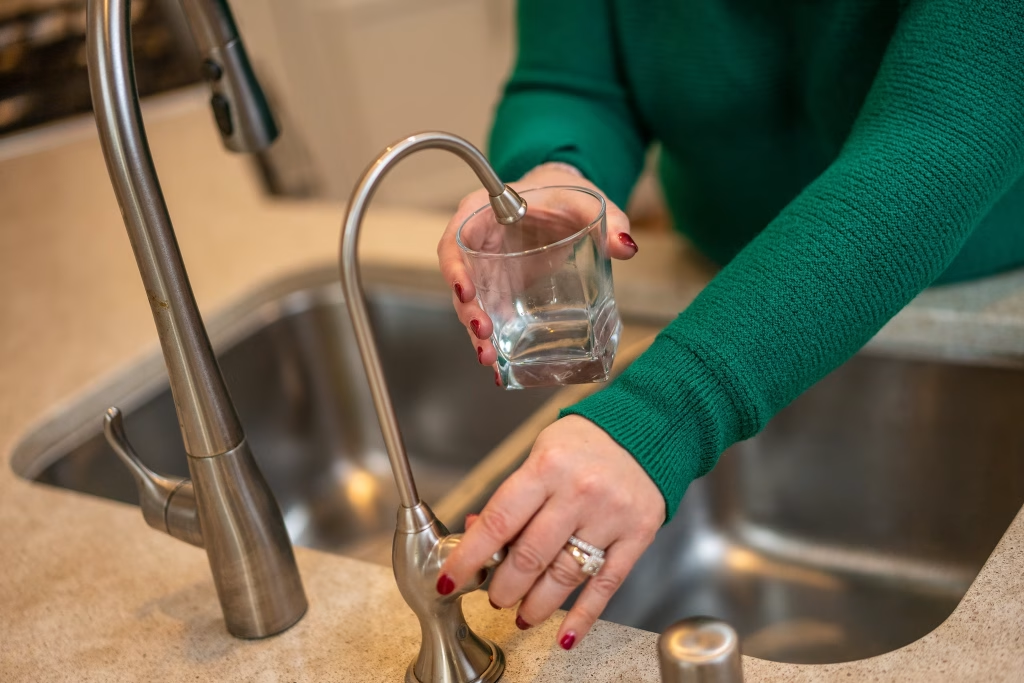One of the more common questions we receive is about the options for drinking water filtration. Two of the leading technologies for drinking water filtration are carbon-based filters and reverse osmosis filtration.
They are decidedly different technologies with very different levels of drinking water quality.
What is Removed: Reverse Osmosis v. Carbon Filtration
| Water May Contain: | “Reverse Osmosis / Carbon Combination” | “Carbon Block or Activated Carbon” |
| Bad/Foul Taste | Removes | Improves |
| Odor | Removes | Improves |
| Turbidity | Removes | Reduces |
| Organic Compounds* | Removes | Removes |
| Chlorine & THMs | Removes | Removes |
| Bacteria | Removes | May Control Growth** |
| Viruses | Removes | Will Not Remove |
| Cysts | Removes | Removes Some |
| Parasites | Removes | Removes Some |
| Arsenic | Removes | Will Not Remove |
| Heavy Metals*** | Removes | Removes Some |
| Dissolved Solids**** | Removes | Will Not Remove |
| Fluoride | Removes | Will Not Remove |
*Organic Compounds – include Pesticides, Herbicides, and Insecticides.
**Silver-Impregnated Carbon – can control bacterial growth.
***Heavy Metals – include Iron, Lead, Cadmium, and Aluminum.
****Dissolved Solids – include Sodium, Calcium, Magnesium, and inorganic minerals.
Carbon Filters
Carbon filtration is one of the oldest technologies on the planet. These types of filters cover a broad spectrum of options.
On the extreme low-end, that’s carbon gravel. These are the refrigerator filters or Brita cartridges. It’s the same carbon gravel you buy in an aquarium store. These filters will remove some chlorine.
Better filters would be carbon in a block form, some being “activated carbon” or similar. Most of these will remove more chlorine.
A high-quality carbon filter is often more effective than a low-end reverse osmosis system. An example of this would be our Always Fresh filter. It removes 99.99% of chlorine. It will remove volatile organic compounds and heavy metals.
A reverse osmosis system will use a high-quality carbon filter. These are often called the “taste and odor” filter.
Reverse Osmosis
Reverse osmosis is a membrane technology. These thin-film composite (TFC) membranes force water over a semi-permeable membrane.
Most will consist of three stages:
Pre-Filter: The purpose is to remove sediment and particulate that can ruin the filter.
Membrane: This is the important part and quality matters. The membrane is what separates out the water from the non-water.
Post-Filter: This is the taste & odor part of the system. Carbon filters will “polish” the taste and flavor of the water.
Be wary of 4-stage, 5-stage, or 20-stage systems. They’re usually just unnecessary, redundant filters. Read: Gimmick that increases your cost of operation.
Better systems, such as our Kinetico K5 Reverse Osmosis, will have expansion ports. This isn’t for two taste and odor filters, but for an optional system expansion. Examples would be specific-purpose cartridges such as:
- Arsenic elimination
- Mineral addition / pH adjustment
- Virus guards
The Difference
These two technologies are different. Carbon is not bad, we use it for whole-home dechlorination. When it comes to drinking water, there is a massive difference.
The difference between reverse osmosis and carbon filtration is, simply, that size matters.
Everything in water has a size. This is measured in microns. Most carbon filters have NSF Class I ratings. This means that they remove 85% of particles sized 0.5-1 micron.
Reverse osmosis systems can filter down to .001 micron. That’s a 500x’s size difference in capacity.
